Growing Your Business By Targeting Your Smallest Viable Audience
Originally posted on https://www.eminentseo.com/blog/growing-your-business-by-targeting-your-smallest-viable-audience/
Business isn’t the same as it was 10 years ago. The internet changed the world in ways we’re still trying to fully understand.
Companies can no longer continue on the same path as their larger rivals. In the past, old school business models provided a format for up-and-coming entrepreneurs to follow. But in today’s business world, that format doesn’t work.
For the first time in history, the five most valuable companies in the world are all tech companies:
- Apple
- Alphabet (Google)
- Microsoft
- Amazon
And, unlike their outdated counterparts, today’s tech companies are agile and fast. They work with designers and creators empowered to innovate and make better systems and solutions soon to become adopted as the new norm. The ability to test and fail means fail and fail more often. And failing more often means more chances for success as well.
The rules are different now. It seems like tactics have overtaken strategy and short-term wins have become more important than long term gains.
With the rules of business changing, the marketing rules have changed along with it. Before the internet, marketing a new brand required creating mass appeal. Today, in the digital marketplace, targeting the masses is just not a great strategy.
You see, targeting the masses means creating a product or service with a brand and message that appeals to everyone. And online, ‘everyone’ is any number of the 7.7 billion people that exist on the Earth today.
Check the Current World Population here
What brand has the capacity to appeal to billions of people? What start-up enterprise could even afford to market to everyone?
Of course every entrepreneur dreams of reaching a maximum market reach. Every artist dreams of having millions of fans and followers… and every hard working business owner hopes to realize high-yielding returns on investments.
But, the problem is, the masses like AND hate everything. They love humor, though are offended by it as well. They care about art and design or function and efficiency. They are carnivores and vegetarians. They are advocates and adversaries….
The masses are everyone. You and your brand are singular, with a message and story that are meant to call your own, initially. And, if you dumb it down to please everyone, you take out the very element that makes you unique.
Seek the minimal viable audience
You’ve heard it before, today’s marketing is about storytelling. It’s about surprising and delighting the audience.
Chances are you’re not going to delight very many people if your message is watered down for the masses. Instead, determine who your minimal viable audience is, and go after them. Hard.
Why waste your time on other people who, for the most part, don’t really care about what you’re trying to do?
When you focus on your minimal audience, or specific buyer personas, the aspects of your messaging and story will become more impactful to the individuals who matter.
From one of my favorite authors and the person who inspired this post, Seth Godin:
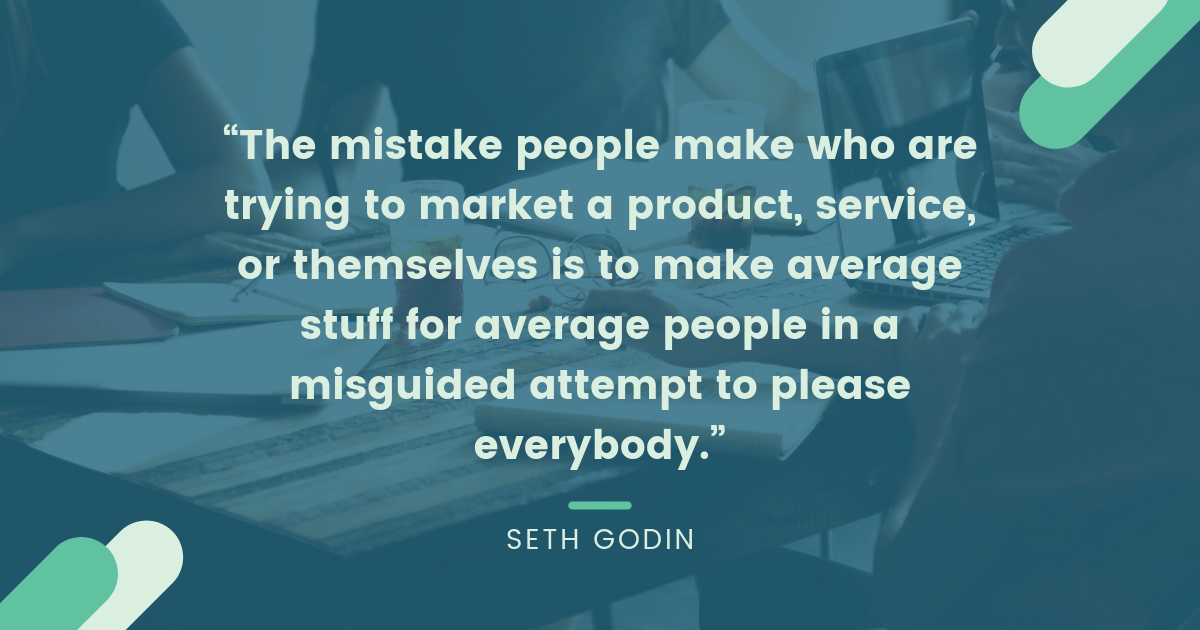
But the problem is, when you’re trying to make the best, the best is different for everyone.
Who is your minimum viable audience?
To understand who your minimum viable audience is, consider the smallest group of people you could target or work with that will sustain your business.
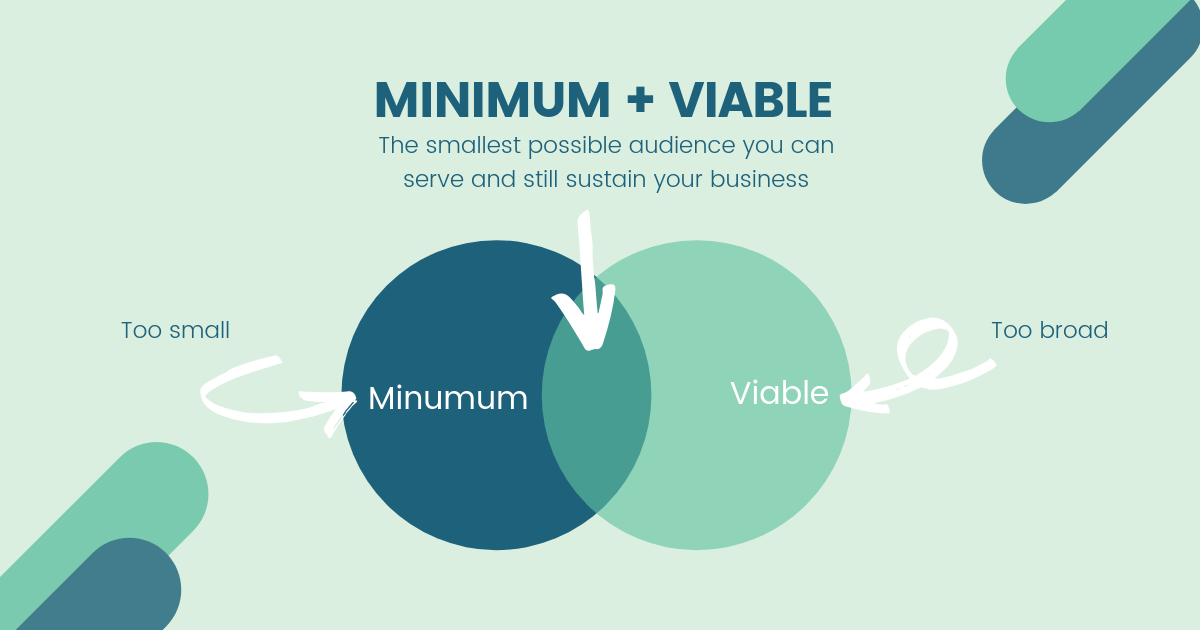
When you’re just getting started, it’s hard to determine an ideal buyer. More seasoned marketers will tell you this set of information is developed from layers of data pulled from years of marketing campaigns. However, when you’re working with a new brand, a new concept, a new service or a new division, the old data won’t tell you who your new audience could be.
Instead, this is the time to dream a little. To make a wish list of who your audience would be, if you could choose. Imagine their hopes, their vision, their views on the world, what they’re passionate about, why they do what they do… it’s all up to you.
Now, what would you make to help improve their lives? What would you choose to make specifically for them because they are the only ones watching? Because, remember, in your dream vision of who your audience is, there are only people who care about you and what you’re doing.
To take the exercise a step further, pretend you’re minimal viable audience consists of only 10 people. That your entire mission is to entertain these 10 people. That everything you build, everything you say, everything you share only has one job: to delight these 10 people.
Would you still be making the content you were making now? Would you still be sharing the same messages and offering the same services you are today?
Ignore the non-believers
It’s really easy as a business owner or entrepreneur to get distracted by the haters. There will always be non-believers and people who think things should be done differently. Don’t get caught up in what they might say or how they might react to what you’re creating. Remember, you’re not creating it for them.
By concentrating on the few and ignoring the non-believers you can stay focused on the work that matters.
Then, ironically, your work will spread.
The only way to create anything with meaning is to find the right audience and make things for them. When you work for people or on projects that aren’t in line with your mission, you prevent that magic from happening.
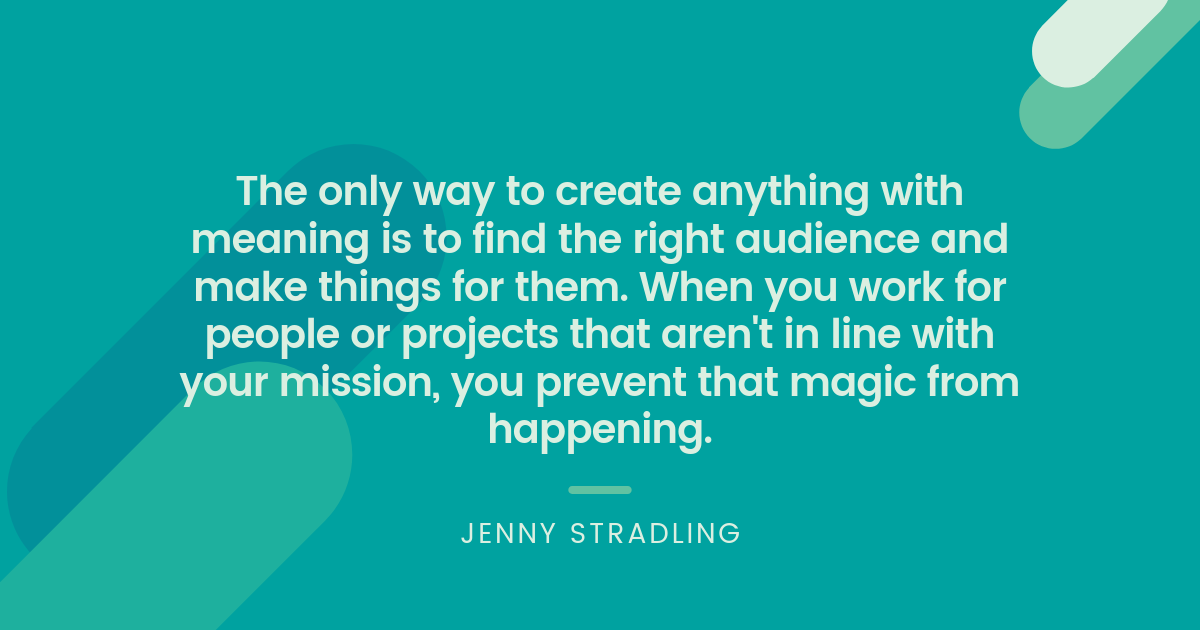
I know this because I’ve been there. I know this because I spent 10 years trying to figure out who I wanted my audience to be and, let me tell you, the struggle is real.
Redefining your target audience
If after years of doing business or working towards a project online, you have found yourself questioning your target market and strategy, you’re not alone.
Unfortunately, if you’ve been primarily working with an industry that has undergone significant changes, you can be impacted for a number of reasons.
Industries change all of the time, especially in today’s fast-paced, digital solutions based world.
If you’re getting ready to do a complete company rebrand or simply tweak your marketing messaging, here are some questions you can ask yourself:
- Look at your current customers. Are your solutions solving the problems these people handle on a day-to-day basis?
- Have your solutions changed? Do you need to adjust to accommodate your client base or should you go after a new market completely?
- If you’re going after a new market, does this audience typically purchase products or services that are similar to yours?
- Why are you offering this specific product or service?
- What are your target demographics?
- Where do they live? Where do they work?
- What do your buyers have in common?
- What are their values, interests and hobbies?
- How does your target audience engage with others online?
- What drives this audience to make buying decisions?
- How can you best reach your target market?
- What are the other brands your target audience already follows and engages with?
Each of these questions should be deeply considered and researched before you decide to change your branding and messaging.
Be the best option available
In an instant gratification world where there are literally endless online results for any type of query you can think of, users demand the best.
Buyers only care about the best.
People don’t want the average T-shirts. They want THE best T-shirt online.
But how can you be the best T-shirt for everyone?
Being the best for a select few, by offering something made for your minimum viable audience. Target the people who share your views and mission. The people who are inspired by your message and want to wear a shirt that represents and honors who they want to be in the world.
If you are a sustainable business for example, and you’d like to sell merchandise, story building around your world views and your message regarding the importance of people, and planet before profit, is key to resonating with your audience.
A person’s way of viewing the world and how they interact with brands is a big indicator of how they make decisions and the types of stories that compel them to act.
If you think about it, a worldview can be an even more effective way to identify market segments than simply utilizing customer demographics. What people believe to be true is a more accurate predictor of online behavior than age, gender, or even social or economic attributes.
Tips for using worldviews in your value proposition strategies:
Ask yourself the following questions:
- What do your potential and current customers strongly believe to be true?
- What do they value and what do they think is irrational?
- How do people perceive the world today?
- What benefits do I offer that contrast with the general market?
- Have we discovered something unusual or surprising that we’d like to share?
Target audience versus value proposition
Now that you’ve defined your target audience or redefined your buyer persona types, it’s time to address your value proposition statement.
A value proposition statement indicates why a customer would choose your brand over another. It explains your angle in the marketplace and includes things like costs and benefits to show the value that your organization can deliver to its customers.

When determining your value propositions, you first must review the problem you aim to solve. Similar to developing out your target audience strategy, it’s imperative that you understand your buyers and their needs so that you can be sure your offering fits the demand.
If the demand is there, but your sales are still down, here are some other questions you should be asking:
- Who is my competition and how am I different from them? You need to see how you stack up against others in your space. Take a look at things objectively and make decisions for your own brand that you know will help you stand out.
- What pain points does my product or service solve? How does your business or product solve a problem for your customer? Does it save time? Money? What is it that you provide that similar companies don’t?
- What is my mission? What is your company’s vision? What do you stand for? Developing a mission requires you to answer three additional questions:
- Why is it important to us?
- What is our ultimate goal?
- How will we measure our success?
Once you’ve determined your unique mission as a brand, this will also help you distinguish what sets you apart from your competition.
Here is an example of a great value proposition that has evolved over time:
Company: Dollar Shave Club
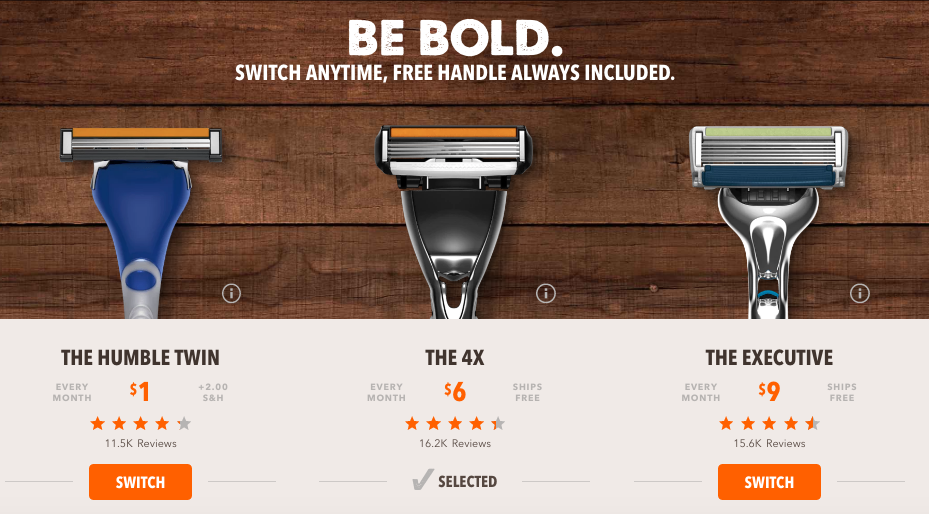
Image cred: Frugalbeautiful.com/blog
This brand has been disrupting the razor industry since they first came onto the scene with their viral video campaign in 2012. They literally built their business around the pain and inconvenience of having to go to the store and spend a lot of money for big-name razors from “those other guys”.
Their solution? A low-cost razor that gets delivered right to your door on a convenient, automated basis.
Over the years their messaging has evolved to better reflect their unique value proposition.
Originally posted on YouTube by Dollar Shave Club
They started with a slogan of “Our blades are f***ing great”, which is a nod to the humor you see throughout their advertising campaigns. However, in more recent years, you can see they cut back on the humor a bit and went for an even more direct approach.
Clever taglines and incorporating humor can be great tactics to help a new brand stand out. However, as a brand becomes more recognized and has a stronger following, it makes sense that their messages would evolve with them over time.
Dollar Shave Club clarified their message and, in doing so, helped take their startup and viral video campaign into a billion dollar business venture for the founder.
You see, on July 19, 2016, Dollar Shave Club was acquired by Unilever for a reported $1 billion in cash. Not too shabby. Source: WikiPedia.
What else can we learn from Dollar Shave Club?
-
What video can do
Look, I’m probably preaching to the choir here but in today’s marketplace, video is more powerful than ever.
Video provides a brand with the opportunity to establish a direct connection with their audience. It’s a visual experience that can only be provided in this format.
Dollar Shave Club came up with a concept that would work well in a video format. But,making a video isn’t enough. You get a sense that the promotion of this video was strategic, not just viral, as the campaign piggybacked off of a press release, that appeared to help pivot the already live video into the eyes of a wider audience.
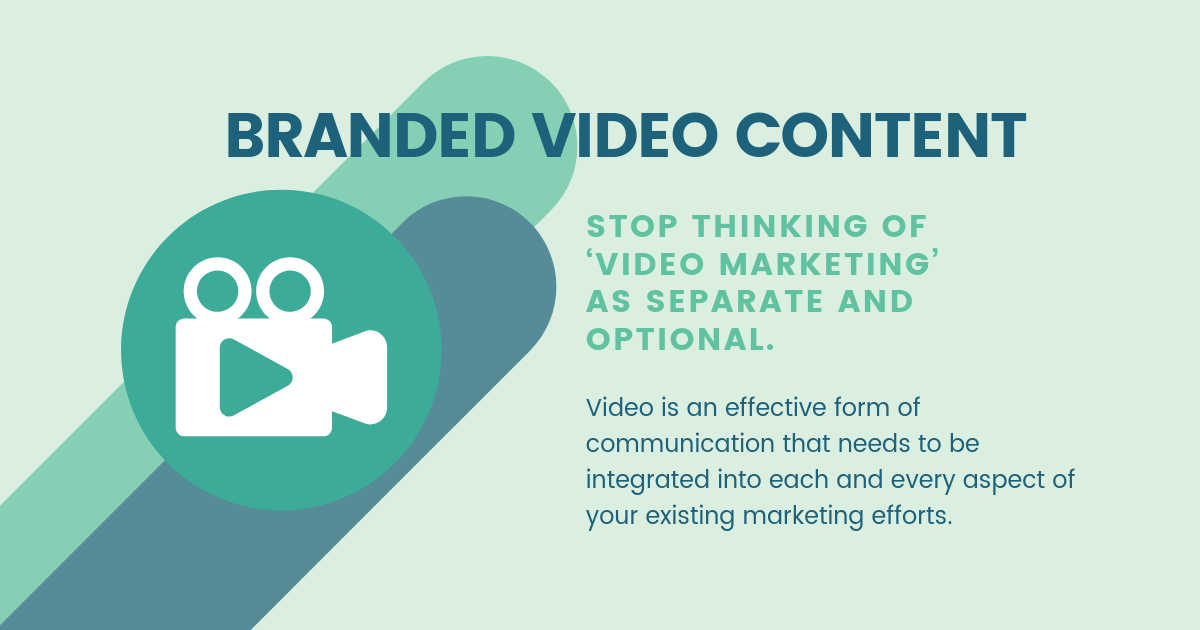
-
How important storytelling is
Today, digital marketing can be focused on any number of platforms and mediums. But the distribution of an asset, such as a video, is only as good as the story the brand has to share.
Dollar Shave Club didn’t just make a video to share on YouTube or social outlets, they determined who their minimum viable audience was and focused on delivering compelling stories.
Video and YouTube, in this case, were the obvious choices to distribute the content and reach the targeted audience. Dollar Shave Club took advantage of that in a smart and unique way.
-
The value in knowing (and targeting) your audience
I think it’s pretty safe to say that Dollar Shave Club knew their target audience well. They used language and humor to reach people in a new way. Prior to their unique campaign launch, most razor brand positioning and messaging seemed to focus on the more serious side of their audience.
Knowing their audience allowed them to take bigger risks with their marketing, delighting their minimal viable audience, turning strangers into leads, customers, and loyal brand promoters.
-
Why value propositions matter
Marketing and messaging for a brand today can span the full digital spectrum, from your website to your social and email campaigns.
Catchy one liners and humorous videos are not enough on their own to push the buyer along the journey from awareness into consideration and, eventually, a purchase. By combining their unique messaging with powerful proposition statements throughout their digital properties, Dollar Shave Club created a campaign focused on what makes them better than the competition, at every stage of the journey.
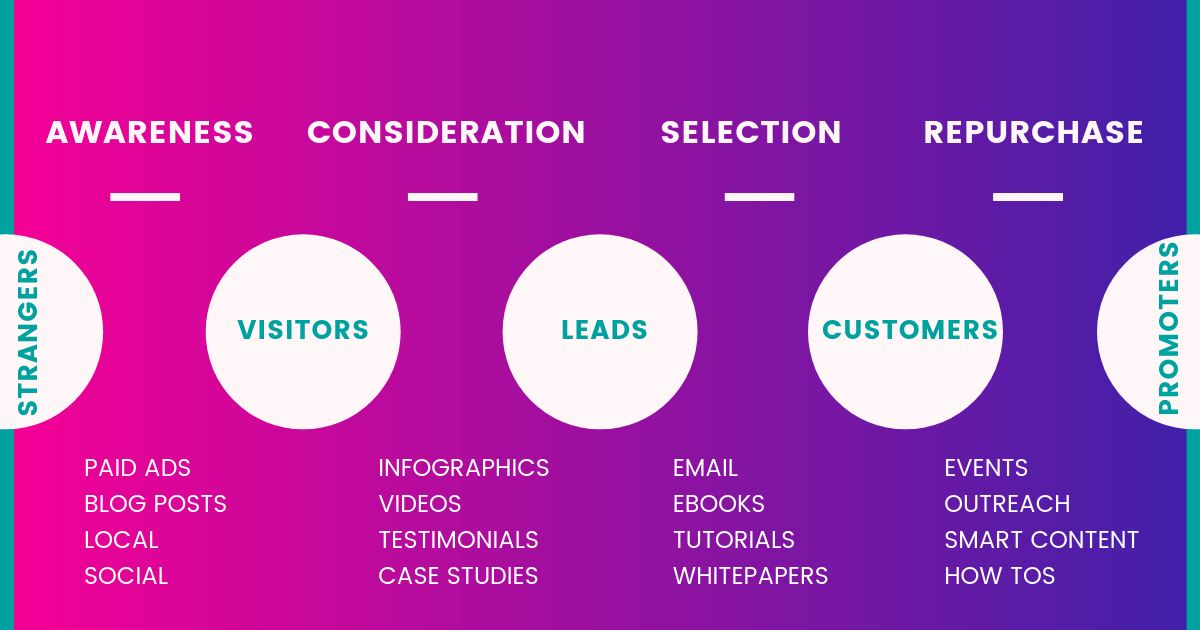
-
How viral marketing is about shareability
I always thought it was strange how much money was invested into large advertising campaigns that only aired on television. Digital media is shareable and therefore the type of content that can reach a much larger audience. If you’re creating messaging that can go viral, why wouldn’t you provide an easy path for your audience to share that content?
You can’t share TV ads unless they’re online. Dollar Shave Club knew this and used their traditional media in their online marketing strategies as well.
That’s not only a great way to build trust through consistency in your messaging, but also just a smart way to repurpose “physical” assets into digital assets for the brand (aka turning a TV ad into a YouTube video).
Repurposing saves the company money by not having to make new assets for every platform.
-
How humor (being authentic) can work for any brand
Marketers will tell you they’re very specific reasons that people feel compelled to share content. Everyone has their own emotional triggers, but the average person is said to feel inclined to share a piece of content if they experience: anger, shock, awe, humor, sadness or another strong emotional connection that they believe is relatable to their peers.
The Dollar Shave Club video is clearly made to poke fun at the brand, in an amusing way. That works for them and their audience. But that doesn’t mean that every brand story needs to include self-deprecating humor.
The point is, they knew their audience and built a message that would work well for them.
Authenticity is what really matters in brand storytelling.
What do you think?
-
- How did you determine your minimum viable audience?
- How did you come up with your unique value proposition?
- How do you use it for smarter marketing?
- When should you redefine your value proposition?
- What can you take away from successful brand campaigns that focus on the minimum viable audience and a defined value proposition?

